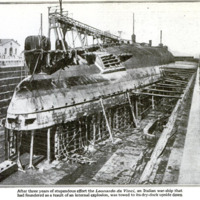-
Title (Dublin Core)
-
Italian war-ship Leonardo da Vinci
-
Article Title and/or Image Caption (Dublin Core)
-
Upside Down to the Dry-Dock
-
Caption: After three years of stupendous effort the Leonardo da Vinci, an Italian war-ship that had foundered as a result of an internal explosion, was towed to its dry-dock upside down
-
extracted text (Extract Text)
-
WHEN a huge vessel, such as a
‘war-ship, is brought to the dry-
dock upside down, one can
imagine the magnitude of the calamity
that caused the wreck. On August
2-3, 1916, when the Italian war-ship,
the Leonardo da Vinci, was resting at
anchor in the channel of the Mar
Piccolo, a fire broke out in the munition
stores in the stern. Immediately there
occurred a gigantic explosion, tearing
two great holes in the vessel and
causing it to founder. More than two
hundred seamen were killed, and
twenty-one officers were among the
missing. Subsequent inquiry attrib-
uted the cause of the disaster to two
Italian workmen employed in the
arsenal, and the men were consequently
shot as traitors.
The holes in the war-ship torn by
the explosion were about thirty-two
feet in length and sixteen feet wide,
and were open mouths into which the
turmoil of swirling water poured, the
inrushing currents causing the vessel
to capsize. The turrets and upper
works rested finally in the soft mud on
the bottom of the channel. The keel
and part of the bow remained above
the water, the depth being about
thirty-six feet.
‘What would be the quickest way to
get rid of the obstruction? At first
the ship was regarded as lost. But,
being in sheltered water not far from
the arsenal, the officers in charge began
to consider proposals as to how the
wreck might be salvaged. One sug-
gestion was to build a dike around the
ship or to roll it over on the bottom
until it assumed an upright position.
The task of salving the war-ship was
given to General Ferrati. He sug-
gested that, instead of trying to turn
the ship over, it could be floated in its
unfortunate position, and upon this
plan the work was started.
Divers found that in “turning
turtle” the ship had nearly severed the
firing turrets. These were removed,
and some of the cannon were raised
from the mounts. Then the explosion
holes were plugged. After this ex-
tensive preparatory work, pumps
removed the water from within the
hull. The water was brought down
to twenty-six feet in almost the entire
ship, and the munitions in the central
and foremost stores weresaved. Then
a successful attempt to save the coal
was made.
The portholes and other openings
had been plugged when the large rents
torn by the explosion were closed, and
with the removal of the water came
the next step—floating the vessel.
Compressed air was pumped into the
hull, making it a huge caisson in which
workmen could continue their work.
After twelve months of stupendous
effort the weight of the vessel, after the
removal of its exterior detachable
parts and its munitions and coal, was
reduced from 24,000 tons to 18,000
tons. Then eight cylindrical barrel-
like tanks were employed to lift the
ship from the bottom and make it
ready to be towed to the dry-dock.
Four tanks, each weighing four
hundred tons, were attached to the
bow, and four were attached to the
stern to give the necessary stability to
the ship while being lifted. The
bastion of the second turret was re-
moved with great difficulty during the
lifting of the stern of the war-ship.
‘When the decks, upside down, were
cleared, the work of actually floating
the ship in its curious position was
completed, and the towing to dry-
dock began. It was at the beginning
of September, 1919, more than three
years after the disaster, that the
ship was finally towed upside down
to its dry-dock.
-
Language (Dublin Core)
-
eng
-
Date Issued (Dublin Core)
-
1920-04
-
pages (Bibliographic Ontology)
-
61
-
Rights (Dublin Core)
-
Public Domain (Google digitized)
-
Archived by (Dublin Core)
-
Filippo Valle
-
Alberto Bordignon (Supervisor)
 Popular Science Monthly, v. 96, n. 4, 1920
Popular Science Monthly, v. 96, n. 4, 1920



